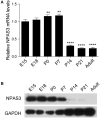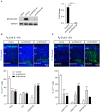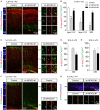Npas3 regulates stemness maintenance of radial glial cells and neuronal migration in the developing mouse cerebral cortex
- PMID: 36313621
- PMCID: PMC9608153
- DOI: 10.3389/fncel.2022.865681
Npas3 regulates stemness maintenance of radial glial cells and neuronal migration in the developing mouse cerebral cortex
Abstract
The neuronal PAS domain 3 (NPAS3) is a member of the basic helix-loop-helix (bHLH) PAS family of transcription factors and is implicated in psychiatric and neurodevelopmental disorders. NPAS3 is robustly expressed in the cortical ventricle zone (VZ), a transient proliferative zone containing progenitor cells, mainly radial glial cells, destined to give rise to cortical excitatory neurons. However, the role of NPAS3 in corticogenesis remains largely unknown. In this study, we knocked down Npas3 expression in the neural progenitor cells residing in the cortical VZ to investigate the role of Npas3 in cerebral cortical development in mice. We demonstrated that Npas3 knockdown profoundly impaired neuronal radial migration and changed the laminar cell fate of the cells detained in the deep cortical layers. Furthermore, the downregulation of Npas3 led to the stemness maintenance of radial glial cells and increased the proliferation rate of neural progenitor cells residing in the VZ/subventricular zone (SVZ). These findings underline the function of Npas3 in the development of the cerebral cortex and may shed light on the etiology of NPAS3-related disorders.
Keywords: NPAS3; cerebral cortex; neuronal migration; radial glial cells; stemness maintenance.
Copyright © 2022 Liu, Li and Zhang.
Conflict of interest statement
The authors declare that the research was conducted in the absence of any commercial or financial relationships that could be construed as a potential conflict of interest.
Figures





Similar articles
-
Npas3 deficiency impairs cortical astrogenesis and induces autistic-like behaviors.Cell Rep. 2022 Aug 30;40(9):111289. doi: 10.1016/j.celrep.2022.111289. Cell Rep. 2022. PMID: 36044858
-
NPAS3 Regulates Transcription and Expression of VGF: Implications for Neurogenesis and Psychiatric Disorders.Front Mol Neurosci. 2016 Nov 8;9:109. doi: 10.3389/fnmol.2016.00109. eCollection 2016. Front Mol Neurosci. 2016. PMID: 27877109 Free PMC article.
-
Molecular analysis of NPAS3 functional domains and variants.BMC Mol Biol. 2018 Dec 3;19(1):14. doi: 10.1186/s12867-018-0117-4. BMC Mol Biol. 2018. PMID: 30509165 Free PMC article.
-
Proneural genes in neocortical development.Neuroscience. 2013 Dec 3;253:256-73. doi: 10.1016/j.neuroscience.2013.08.029. Epub 2013 Aug 30. Neuroscience. 2013. PMID: 23999125 Review.
-
Molecular Pathways Underlying Projection Neuron Production and Migration during Cerebral Cortical Development.Front Neurosci. 2015 Dec 17;9:447. doi: 10.3389/fnins.2015.00447. eCollection 2015. Front Neurosci. 2015. PMID: 26733777 Free PMC article. Review.
Cited by
-
Dimerization Rules of Mammalian PAS Proteins.J Mol Biol. 2024 Feb 1;436(3):168406. doi: 10.1016/j.jmb.2023.168406. Epub 2023 Dec 16. J Mol Biol. 2024. PMID: 38109992 Free PMC article. Review.
-
Genetically Engineered Brain Organoids Recapitulate Spatial and Developmental States of Glioblastoma Progression.Adv Sci (Weinh). 2025 Mar;12(10):e2410110. doi: 10.1002/advs.202410110. Epub 2025 Jan 21. Adv Sci (Weinh). 2025. PMID: 39836549 Free PMC article.
-
Decoding the Gene Regulatory Network of Muscle Stem Cells in Mouse Duchenne Muscular Dystrophy: Revelations from Single-Nuclei RNA Sequencing Analysis.Int J Mol Sci. 2023 Aug 5;24(15):12463. doi: 10.3390/ijms241512463. Int J Mol Sci. 2023. PMID: 37569835 Free PMC article.
-
KAT5 regulates neurodevelopmental states associated with G0-like populations in glioblastoma.Nat Commun. 2025 May 9;16(1):4327. doi: 10.1038/s41467-025-59503-w. Nat Commun. 2025. PMID: 40346033 Free PMC article.
-
Sceptic: pseudotime analysis for time-series single-cell sequencing and imaging data.Genome Biol. 2025 Jul 17;26(1):209. doi: 10.1186/s13059-025-03679-3. Genome Biol. 2025. PMID: 40676652 Free PMC article.
References
LinkOut - more resources
Full Text Sources
Molecular Biology Databases

